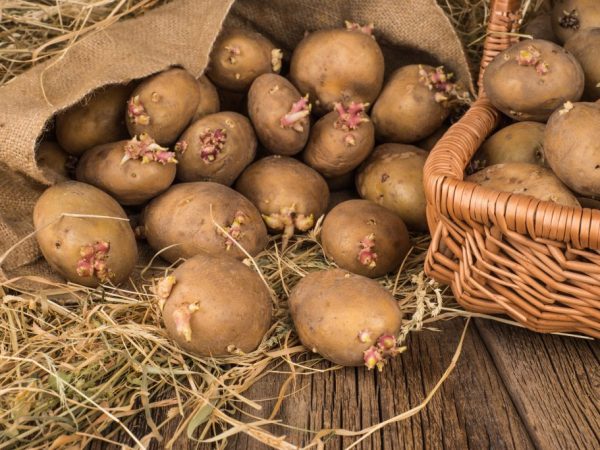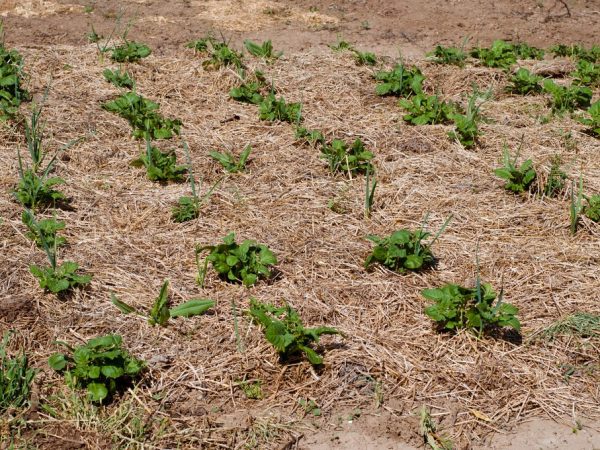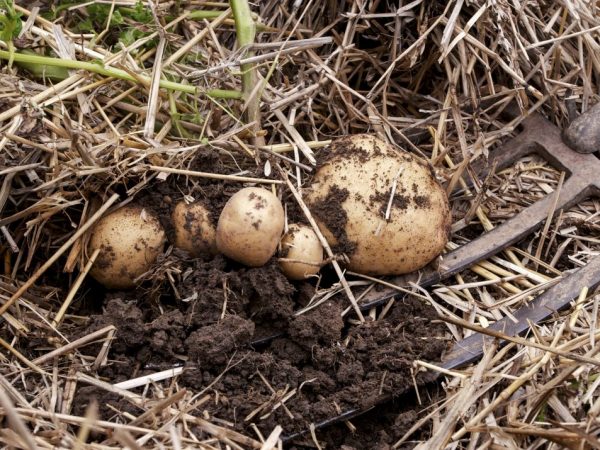How to plant potatoes according to the method of Galina Kizima
In the process of growing nightshades, one has to deal with soil depletion, especially in small areas, where it is not possible to change the place of planting every time. In such cases, alternative cultivation methods are used. Planting potatoes according to the method of Galina Kizima implies a refusal to dig up a vegetable garden.

Rules for planting potatoes according to the method of Galina Kizima
The essence of the method
Galina Kizima has written several books in which she describes her method of growing potatoes, calling her creation a "smart bed". Galina Kizima grew potatoes on 6 acres and, noticing that over time, the soil loses quality even with fertilization, she began to look for an alternative. Its technology is based on 3 “nots”:
- do not dig up;
- do not water;
- do not cultivate.
If digging occurs from 2 times per season, both pathological and beneficial microorganisms die in the soil. Plus, treatment with fungicides, herbicides and disinfectants completely depletes the soil. As a result, plants lack minerals, and they grow frail, often influenced by all kinds of fungi. Kizima defines the following procedure:
- selection of seed material;
- landing;
- care;
- harvesting.
Tuber preparation
The size of the potatoes should not be larger than the size of the chicken egg. It is in such a fruit that there is a sufficient amount of nutrients that ensure the normal growth and development of the plant. When using small root crops, it is recommended to lay them out at once in 2-3 pieces to ensure a sufficient number of stems, otherwise the quality of the crop will decrease.
At the time of planting, the potatoes must be germinated. The sprouts should grow up to 4-5 cm. This helps the plants survive during temperature extremes in spring. To germinate quickly, the tubers are thoroughly washed, and then they are put in a basin with water heated to 45 ℃. The tubers are kept in liquid until the temperature drops within 18-20 ℃.
Separately, a manganese solution is made, which is added in a thin stream to the basin, stirring until a pale pink color is obtained. Instead of manganese, Fitosporin solution is sometimes used. The tubers are kept in it for 10 minutes, and then the liquid is drained, the roots are washed and dried. Then they start gardening, for which they keep the roots in a well-lit room for 10-20 days.
The potatoes are put in jars and placed on the windowsill, turning periodically to achieve uniform landscaping. After that, Kizima advises to start the germination process. The tubers are harvested in a dark, warm room. On average, it takes 14-21 days to grow shoots.
To increase the number of shoots, each potato should be cut horizontally about 7 days before planting. This move allows you to activate the growth of reserve buds in the lower part of the root crop. If sprouts appeared ahead of time, for example, in winter, they should be removed, otherwise the quality of the harvest will suffer in the future.
Landing

Plants need sunlight
Planting should be carried out in an open, sunny area. Potatoes are a thermophilic plant and require a sufficient amount of light for normal development. The method is aimed at reducing the size of the ground part, which allows you to get even, large tubers.
The optimal time for planting potatoes is the period when the top layer of the earth will be sufficiently dry. To get a good harvest of potatoes, the shoots are well covered so that they are in the dark. Growing potatoes with this method involves learning the principles of plant growth. Tubers are formed not on the rhizome itself, but on stolons - shoots that form on the lower part of the shoots. Such shoots develop well not only in the compost layer, but also under opaque flasks.
Before planting roots, you can carefully remove the top layer of soil, but leave it here in the garden. The marking of the beds is carried out directly over the area of the site, even if there is weed on it. The main thing is not to dig up the soil. Tubers are placed exactly along the markings with a step between rows of 40-50 cm and 25 cm from each other.
In the first row, it is recommended to plant early species, and in the other, mid-season or late ones, in order to stock up for the winter. In the northern and central regions, it is customary to plant early varieties. They can be collected 50-70 days from the moment of planting, they are practically not affected by phytophthora.
Cover for garden beds
To protect the frost, the shoots are covered with dry material with good air permeability. The ideal option is hay. It is not recommended to use straw: it attracts rodents. Alternatively, dry foliage or top dry compost is used.
If the covering material has not been prepared in advance, use newspapers. Cover only the beds themselves. To prevent the shelter from being blown away by the wind, it is covered with lutrasil or burlap on top. After the end of the frost, it is removed and organic fertilizers are applied directly on top of the covering material. Liquid fertilizers are poured between the rows, and the grass is laid on top of the plantings, while not covering the seedlings.
It is strictly forbidden to use a film for covering. Under it, the root crops will begin to rot, as a result, there will be no harvest at all.
Care
Growing potatoes with Kuzima involves removing the buds at the time of their formation. During the flowering period, the plant throws energy into the formation of berries with seeds, as a result, the rhizome develops poorly. As soon as the tops are closed in the rows, the tops are removed.
Such a move allows you to suspend the growth of the ground part and direct forces to the growth of the rhizome. Flowers are left on 2 bushes to be able to determine when to harvest. As soon as the flowers wither, they begin to harvest.
Harvesting

Harvesting is carried out in stages
The first root crops are harvested after the flowers wither. To do this, the cover layer is pushed back and the tubers lying on the surface are collected, then the compost is carefully placed in place. With this method of harvesting, the stolons are not damaged, so the roots continue to develop further.
When the entire crop from a row of early potatoes is harvested, the tops are folded onto the surface of the beds. There is an opinion that the tops of nightshades should not be left on the rows, because they contain the poison solanine, but under the influence of direct sunlight, all the solanine comes out and an excellent fertilizer remains. The main thing is not to cover the tops with weeds. In a similar way, Kizima harvests late potato rows.
What to do with the leftover material
All that is left in the potato garden is left for the winter. Unripe compost completely decomposes during the winter and makes the soil neutral. Under such conditions, you can grow potatoes in the same place for several years in a row, without fear of depletion of the soil.
Galina Kizima offers a method that does not require energy consumption at all, because you do not need to plant potatoes directly in the ground, it is enough to spread the root crops on the surface and sprinkle them with hay. Everything in the garden is used, even weeds are used as a covering material.
Pros and cons of technology
The main disadvantage of the method is the unaestheticness of the beds. With this method of growing potatoes, the garden becomes like a trash can, especially since there are more progressive ways to grow potatoes in a small area, such as growing in containers or mounds. The second and main disadvantage is that Fitosporin or manganese is not able to fully protect the potatoes from the attack of pests and all kinds of diseases.
The phytospore in the compost embankment will develop even faster under the influence of heat, especially after precipitation. In addition, the method is completely unsuitable for large areas, because the buds on 1 hectare of plantings cannot be removed at all. The method has several advantages:
- saving finances on fertilizers and water;
- saving energy on digging and watering;
- ease of harvesting.
The Kizima method of growing potatoes is controversial. It involves the removal of inflorescences at the budding stage in order to redirect the energy of the plant to the growth of the rhizome. Planting potatoes for hay has been used for a long time, and in some cases it gives good results, but is not suitable for every site. At the same time, pests and late blight feel great under a cover of hay and compost, and it will never be possible to get rid of ailments in one fell swoop with the help of Fitosporin.
Unripe compost at the time of decomposition makes the soil acidic, which negatively affects the quality of the crop: potatoes react poorly to increased acidity. Any plant needs care, watering and strict control over the state of the tops. In a layer of compost left for the winter, Colorado potato beetle larvae will feel great. This is another disadvantage of the method.
findings
In general, a combination of the Kizima method and other methods of growing nightshades can produce an excellent harvest. Many farmers, who have compared the yields of plants that have been constantly cared for, and crops grown according to the recommendations of Kizima, note that the former give a greater increase than the latter. Each summer resident chooses how to plant potatoes on his own, depending on the weather conditions of his region and the territory of the site.


